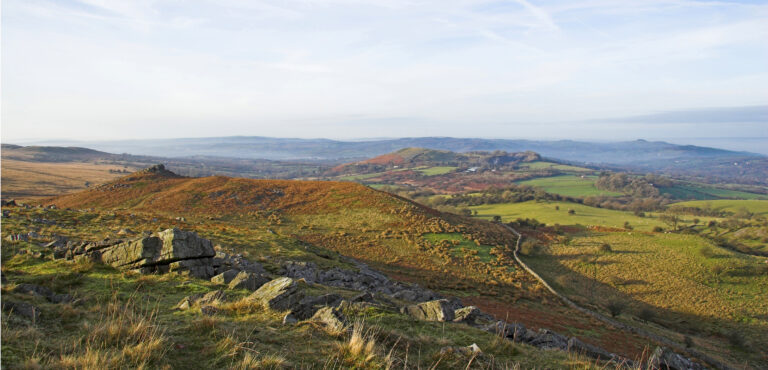Glamorgan Heritage Coast
Glamorgan Heritage Coast

The Glamorgan Heritage Coast – An Introduction
Historically, Glamorgan referred to the area stretching from Cardiff to the Gower Peninsular. Divided up in 1974, the only true county reference to Glamorgan in this area is now The Vale of Glamorgan county. Sandwiched between the M4 at the North, the Bristol Channel and the counties of Cardiff and Bridgend.
Today, the Glamorgan Heritage Coast is the area from Aberthaw to Newton, a distance of 14 Miles.
Driving The Wales Way – Glamorgan Heritage Coast
One epic journey, three distinct routes together.
Dubbed The NC500 For Wales and the Wales version of Route 66, the three routes of The Wales Way showcase 420 miles of Wales’ most exceptional scenery. The Wales Way consists of three distinct routes: The Coastal Way, the Cambrian Way, and the North Wales Way. Each route offers unique and diverse experiences, but in this article, we will focus on the Glamorgan Heritage Coast.
This website is supported by our readers so if you buy through links on this site we may earn a small commission at no extra cost to you.
Historically known as the ‘crucible of the Industrial Revolution’, it was once the most populous and industrialised county in Wales. Today the Vale of Glamorgan is one of the wealthiest areas in Wales. Containing Cardiff Airport, MOD and Aston Martin at St Athan. Serviced by both the M4 (J33 and J34) and the A48, comprehensive Bus and Train networks. It is an easy County to visit.
The dramatic coastline boasts, shipwrecks and sand dunes, thatched cottages and castle ruins, Cliffs and caves. For walkers, it has some of Wales’s best coastal scenery. There is also a network of pubs and cafes to keep you fuelled!
The Glamorgan Heritage Coastal path

The Glamorgan Heritage Coast is part of the Wales coastal path. It runs for 14 miles from Aberthaw to Newton near Porthcawl and is home to an astonishingly diverse range of natural geography. It has from cliffs to estuaries, rocky bays, sandy beaches and the most amazing sand dunes.
The yellow-grey cliffs date back to the Jurassic period and are a mixture of Limestone and shale. The power of the weather, apparent by their exposure, is also confirmed by the on-shore wind providing the perfect surf for those wanting to catch a wave.
Visiting the Glamorgan Heritage Coast
You can easily walk the Glamorgan Heritage Coastal Path. This narrative is about accessing the highlights by car.
Starting at Aberthaw.
Aberthaw itself is the home to a disused power plant, on a very pebbly beach. If you decide to walk the path you will have forgotten the silhouette of its utilitarian bulk by the time you arrive at Llantwit Major.
Llantwit Major
The town of Llantwit Major, due in no small part to its railway station, has grown considerably. The rail service reopened in 2005 and has hourly trains in both directions between Cardiff and Bridgend.
Llantwit Major has kept its historic centre. With its tight lanes, if you choose to visit only the Beach here, the drive through town will force you to ‘breathe in’! The road winds between narrow buildings, so please plan your route very carefully. If you are visiting in anything larger than a car it is best to take the route via the high school (Ysgol y Ddraig) rather than the town centre,
https://www.visitthevale.com/attractions/blue-plaques
This area of coastline is a mix of pebbles and sand. At Aberthaw the beach is predominately large pebbles which makes a stroll on the beach quite difficult. However, as your trip continues you will soon see your terrain change. https://www.visitthevale.com/
Nash Point Light House
Completed in just two years, the construction of Nash Point Lighthouse began in 1831. Designed by renowned civil engineer James Walker, this lighthouse stands proudly atop rugged cliffs. It offers a striking silhouette against the dramatic Welsh landscape. Its white cylindrical tower, made of limestone, reaches a height of 37 meters. This makes it an imposing sight for visitors and sailors alike.
Since its construction, Nash Point Lighthouse has been a guiding light for ships navigating the Bristol Channel. Equipped with a powerful Fresnel lens, this lighthouse emits a unique pattern of light that sailors can recognize from afar. Over the years, the lighthouse has played a crucial role in ensuring safe passage for countless vessels.
The lighthouse was electrified in 1968. The last manned lighthouse in Wales, it was finally automated in 1998.
A trip to Nash Point allows you to also allow you to see the Fog Horn House. It’s a peculiar square building with large foghorns on the roof.
On the beach at Nash Point, when the tide is out you may be able to spot the wreckage of the BP tanker driven ashore in 1962.
The area around Nash Point lighthouse is an area of scientific interest. It has wildflower meadows around the lighthouse a haven for rare species, so tread carefully when you visit.
Dunraven Bay
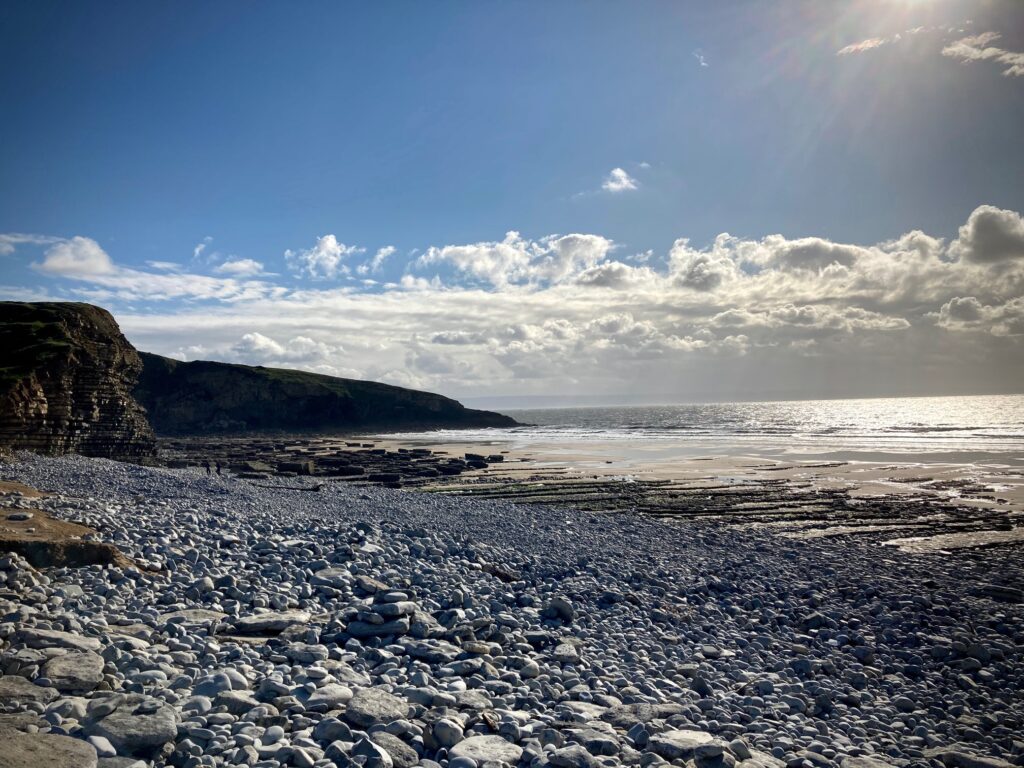
Dunraven Bay is located at the East end of Southerndown, a pebbly beach when the tide is in. However, it benefits from a large sandy beach with rock pools, when the tide is out. For fans of Dr. Who, you will probably know that this is also ‘Bad Wolf Bay’. This is from the series where David Tennant was the Doctor.
The Glamorgan Heritage Coast Centre is here. Taking a hike up the hill will bring you to the ruins of Dunraven Castle. There is also an overflow car park here for the summer months.
Dunraven Bay, also known as Southerndown Beach, is a coastal paradise situated along the Glamorgan Heritage Coast in South Wales. This idyllic stretch of coastline spans approximately 1.5 kilometres and boasts panoramic views of the Bristol Channel. With its golden sands, rock pools, towering cliffs, and crystal-clear waters, Dunraven Bay provides a stunning backdrop for a day of relaxation and exploration.
Dunraven Bay is not only a paradise for beach lovers but also a haven for wildlife enthusiasts. The surrounding cliffs and coastal grasslands are home to various bird species, including gulls, cormorants, and oystercatchers. Occasionally Dolphins are seen in these waters frolicking in the distance.
Dunraven Castle (or in Welsh, Castell Dwnrhefn) was a mansion, with the existing castellated hunting lodge extensively remodelled late in the 19th century. Mostly the house was demolished in 1962, however, some surviving parts include the castle’s walled garden and gatehouse. The surviving parts of the house and its lands are Grade II listed buildings. The area is free to visit and the walled gardens, which were extensively restored in 2013, are lovely all year round.
Ogmore By Sea
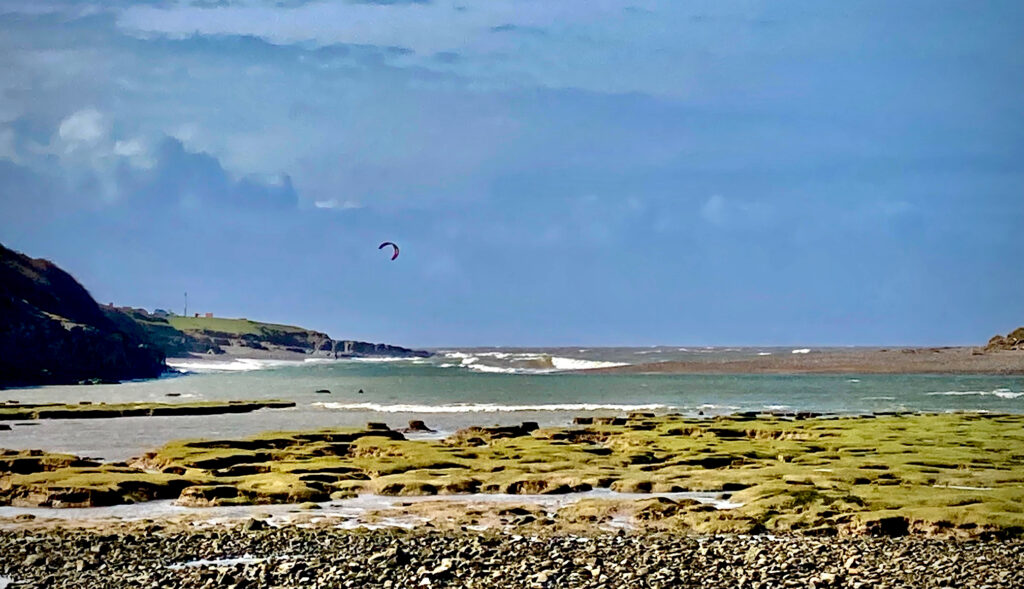
Just three miles south of the town of Bridgend, here the river Ogmore reaches the sea.
The River Ogmore estuary is flanked by Ogmore Beach on one side and the dunes of Merthyr Mawr on the other. Due to the river mouth bathing is often unsafe along much of the beach here. There is a red flag system in place.

The beaches look out on Tusker Rock, (a notorious and brutal reef which is completely covered at high tide). The beaches benefit from a large expanse of sand at low tide.
The shoreline rises to cliffs quickly after leaving the car park at the estuary. You may see fishermen picking their way down the rocks to favourite spots at high tide, The difference between low and high tide here is over six meters so it is not surprising to note that there are a number of beaches (including Hardees’ Bay and Horseshoe Bay and some caves and coves which are only accessible at low tide.

Merthyr Mawr Village: The ‘Chocolate Box’ Village

Merthyr Mawr Approximately three miles from Bridgend this is largely an estate village for the Merthyr Mawr House. Pretty thatched cottages line the village leading up to a medieval church with exceptionally old gravestones towards the back of the churchyard.
Merthyr Mawr Village is a hidden treasure nestled in a beautiful setting. With its stunning landscape and rich history, the picturesque village is set close to the sprawling sand dunes and will add to your experience at Merthyr Mawr.
St Teilo’s
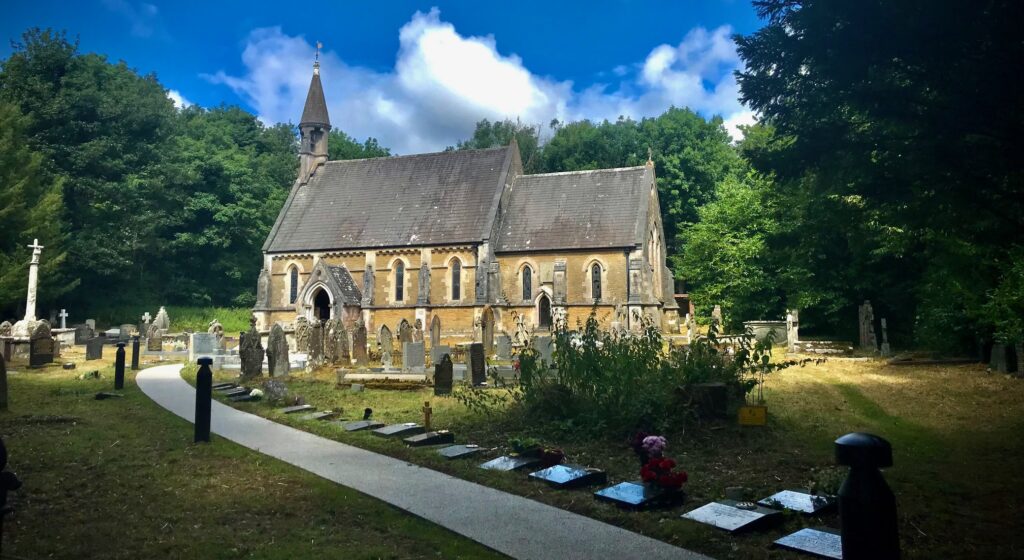
St. Teilo’s is open to the public and sits within exceptionally historic grounds. A visit to the church will reveal a collection of old headstones, curated by Cadw, at the back of the churchyard. The historical items are numbered and an explanation board illuminates the past for you.

On your trip to the village try and find New Inn Bridge, (In New Inn Lane) A Stone bridge, on the route from the A48 to Merthyr Marr. It has 4 arches and dates back to the 16th century or older. Known locally as the ‘Dipping Bridge’. There are two openings in the side of the bridge through which sheep would be pushed to be washed in the river.
A free carpark in the village gives river access and a short walk to the ancient stepping stones at Ogmore Castle.
Ogmore Castle

Ogmore Castle itself is a ruin on the Eastern side of the River Ogmore. Easily accessed from the road to Ogmore Beach, and by foot across the stepping stones (assuming the river isn’t too high). The moat at the castle floods at high tide.
Ogmore is one of three major castle ruins in the area. The other two being Newcastle and Coity which are to the north.
If you drive into Bridgend to visit these castle ruins then also take a moment to enjoy the ancient bridge over the river Ogmore in the centre of town.
If your trip has scope to include horse riding on the beach, then the equestrian centre at Ogmore Castle offers the exhilaration of riding a horse along the pristine shores of Newton Beach. With its wide expanse of sand and gentle waves, the beach provides the perfect backdrop for an unforgettable horse riding experience. Whether you’re a seasoned equestrian or a beginner, there are horses to suit all abilities.
Merthyr Dunes

A Site of Special Scientific Interest covering an area of 840 acres southwest of Bridgend town.
Originally these dunes were part of a continuous stretch that continued to the Gower Peninsula. The Merthyr dunes used to stretch to Kenfig Burrows but construction of farmland and two golf courses have become a barrier, although both sites are designated as national nature reserves.
Merthyr is home to The Big Dipper, a dune, the second-largest in Europe, measuring around 200 feet, and popular with locals for sledging down
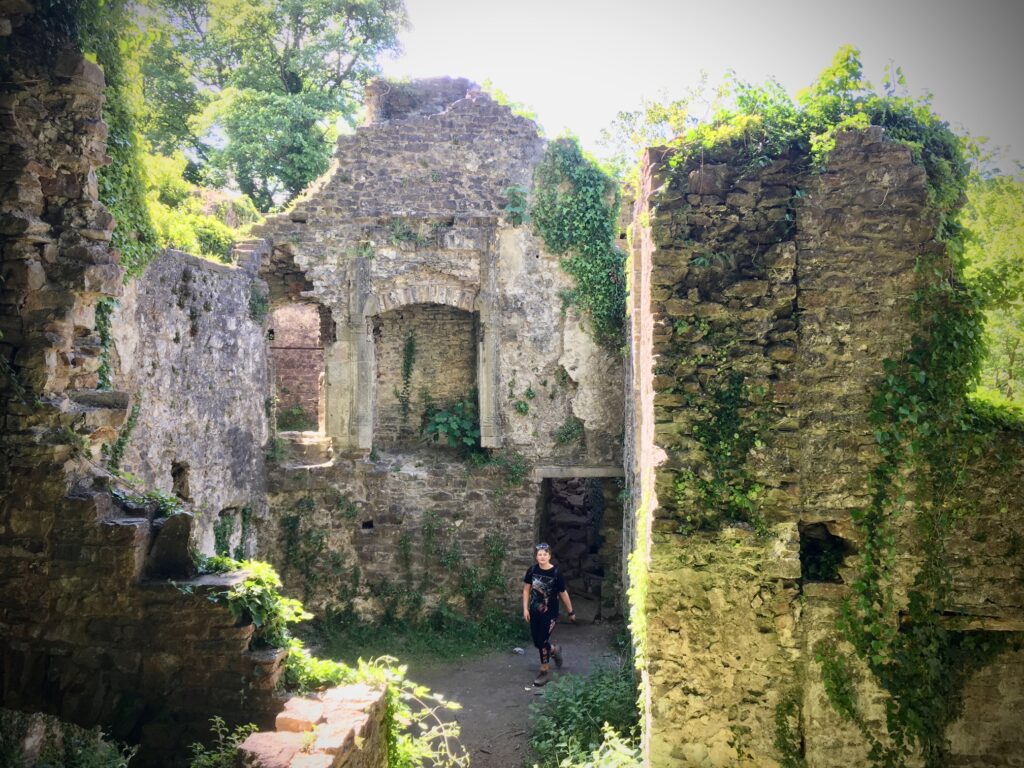
Whilst at Merthyr Marr you may want to also visit the ruin of Candleston castle – more of a lightly fortified 14th century Manor House, which is so close to be practically in the (Paid) car park. Nestled amidst the sand dunes, the ruins of the Candleston Castle tell tales of a bygone era. This historic landmark offers a glimpse into the past and adds a touch of mystery and intrigue to the landscape.
The Glamorgan Heritage Coast – And if you have time…..
If you have time, then try and additionally catch these highlights:-
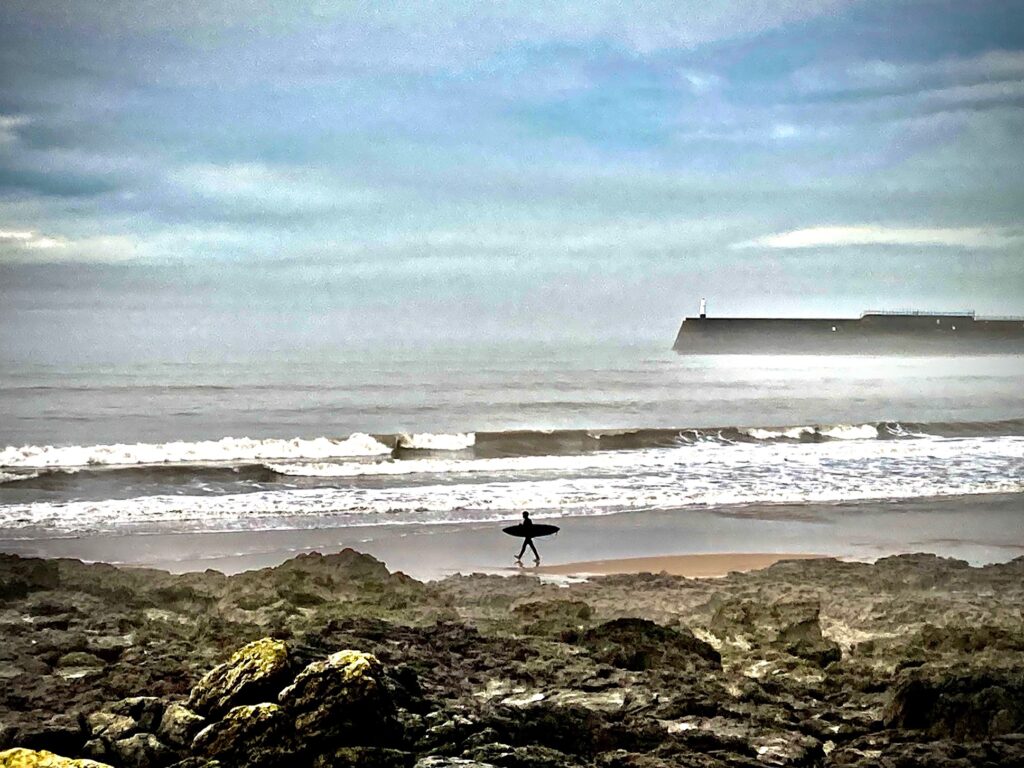
Cowbridge
Cowbridge – Unofficially the Capital of the Vale of Glamorgan, situated off the A48 and to the West of Cardiff, Cowbridge is full of sophisticated shops and plays host to a fantastic food festival each autumn. Unique family shops line the High Street. Including jewellery, leather goods, shoes, antiques and crafts. A wide variety of pubs, restaurants and cafes make eating out in Cowbridge a treat. The town’s history dates back to Roman times, and you can get to know it better by following the Blue Plaque trail. Just off the High Street is Cowbridge Physic Garden, a haven of peace and tranquillity, highlighting the healing benefits of plants. Find out more at www.visitthevale.com
St Fagans
St Fagans – Before you get to the Vale of Glamorgan, on the outskirts of Cardiff (J33 off the M4), lies St Fagans National Museum of History. Centred around St Fagans Castle (Another Elizabethan manorhouse, rather than an actual castle.) the house was donated by the Earl of Plymouth to the National Museum of Wales as a site for an open-air museum. Similar in nature to the Weald and Downland Living Museum in Sussex (home to BBC’s The Repair shop) this site is a collection of ‘re-located’ historic buildings. A way of conserving the past for the benefit of future generations. Entry is free (as are all of Wales’s national museums), and there are a collection of over 40 original buildings within the 100-acre site.
Personal favourites are the work men’s cottages, where working from one end of the row of terraced houses you can see how they have changed over the decades. The Chapel with its amazing original painted interior is a must-see. The Chemist shop is a real step back in time and if you are lucky, you may even find the Blacksmith in residence. This site is continually voted in the top ten on TripAdvisor’s Top Ten free attractions in the UK, so you won’t be disappointed if you break your road trip here for a few hours.
Margam Country Park
Margam Country Park. Found to the West of the Vale of Glamorgan in the County of Neath Port Talbot, but only 9.8 miles or 20 minutes drive from the centre of Bridgend. This location consists of 1000 acres of Country Park set around a Manor House/Castle. With an Orangery, Gardens, a narrow gauge railway and a rare breed farm trail, it’s a great place to spend a few hours.
If you are travelling with kids there are loads of additional things to do. These include a fairy tale village and adventure playground. There is also a deer herd, a sculpture trail, a children’s farm, loads of walking, and a Go Ape Treetop high ropes activity course. It’s dog-friendly and free to get in. There is however a daily Carpark charge. The house itself is owned by the Council. It is occasionally open to the public, as it does benefit from extensive rolling restoration works. Find out more about Margam here
Porthcawl
Porthcawl – Any journey along the Glamorgan Heritage Coast wouldn’t be complete without a visit to Porthcawl. It’s a vibrant seaside town bursting with energy and entertainment with a bucket and spade feel! With its bustling promenade, amusement parks, and golden sandy beaches, Porthcawl is a haven for families seeking fun and adventure. Enjoy indulging in delicious seaside treats, and soak up the lively atmosphere that defines this popular coastal destination.

With its idyllic beaches, captivating landmarks, and warm community spirit, Porthcawl beckons visitors from near and far.
Kenfig National Nature Reserve

Kenfig National Nature Reserve – The Dunes and Beach at Kenfig are part of the larger Kenfig National Nature Reserve, a protected area renowned for its ecological importance. Visitors can embark on guided nature walks and discover the unique habitats that exist within the reserve. The reserve is home to rare species of insects, reptiles, and amphibians, making it a paradise for wildlife enthusiasts and nature photographers. Kenfig Castle, a medieval fortress that once stood proudly in the area, offers a glimpse into the region’s rich history. Although the castle is now in ruins, visitors can explore its remains.
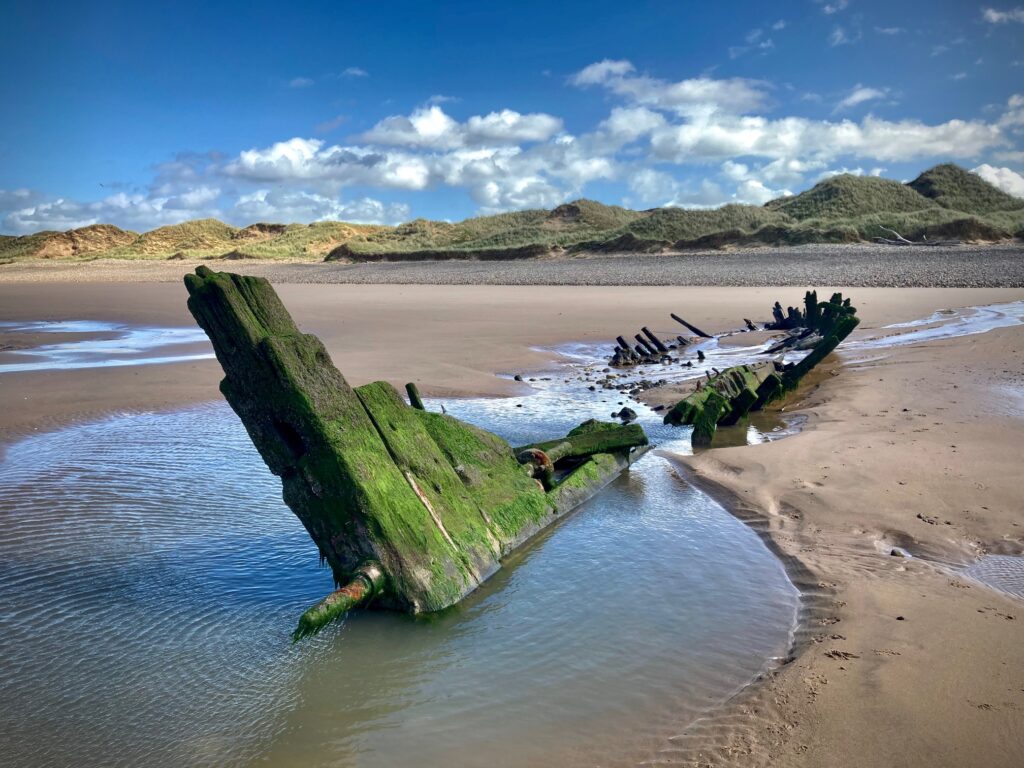
The beach, which is accessed via a twenty-minute walk through the dunes (or along the coast from Porthcawl) is spectacular, dog-friendly, and runs almost to the Steelworks at Port Talbot.
Kenfig Dunes and Beach offers a range of facilities and amenities to ensure a comfortable and enjoyable visit. There are ample (paid) parking spaces available for visitors, as well as clean restroom facilities. Additionally, a visitor centre provides information about the reserve, guided tours, and educational exhibits.
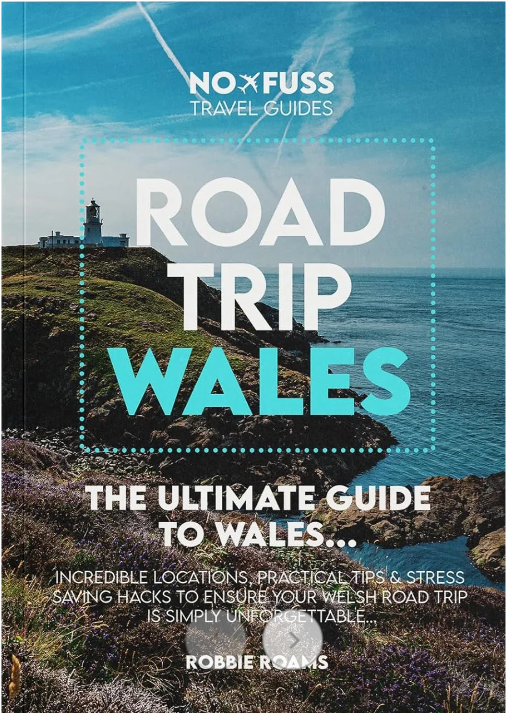
Road Trip Wales Guide Book
Road Trip Wales – the ultimate ‘No Fuss’ Wales guidebook by Robbie Roams. Featuring incredible locations, practical tips and stress-saving hacks to ensure your Welsh Road Trip is simply unforgettable. This in-depth guidebook has everything you could possibly need to plan your Wales road trip, from Wales itineraries to budgeting and accommodation. You’ll have an incredible experience on one of the UK’s best-kept secrets!

Travelling The Wales Way in a Motorhome or Campervan?
We are currently putting together a list of our favourite places to stay overnight including some free park-ups and Campsites.
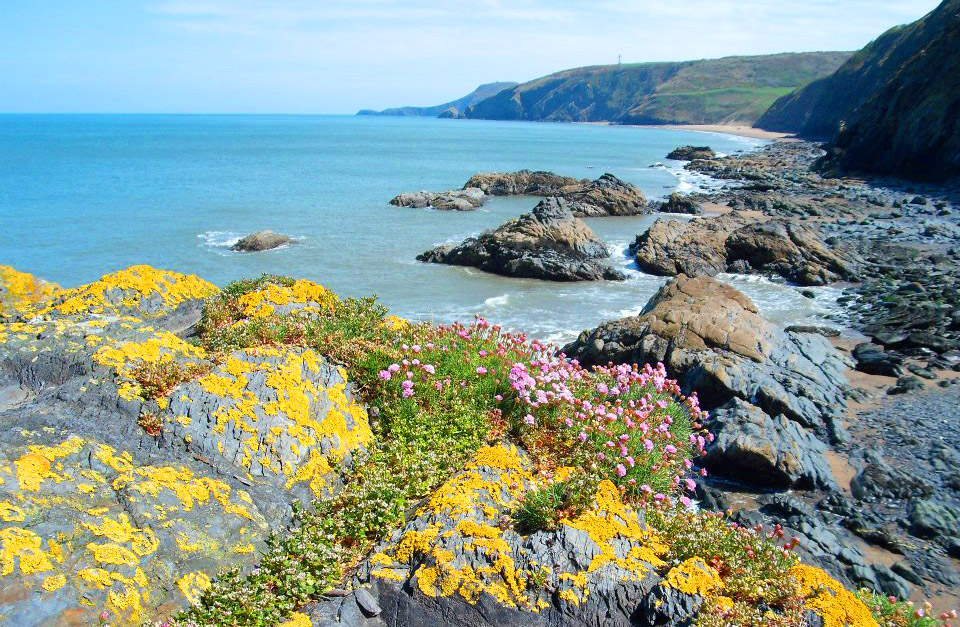
Start Your Coastal Way Journey.
A Coastal wander along the stunning West Wales Coast. Start your Journey HERE

Start Your North Wales Way Journey.
Exploring the North Coast and the Isle of Anglesey. Start your Journey HERE

Discover Wales: Stunning Locations to Visit
Some of our favourite places to visit on a trip around Wales. Find More HERE
Feeling Inspired?
Maybe you’ve driven the Wales Way, or embarked on a Wales road trip? You may have a business on, or near one of the Wales Way routes. Would you like write a guest post for our Wales Way Blog and tell us how you got on? Drop us a line and let us know what you have in mind.









